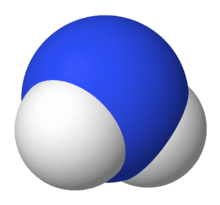Azanide
Azanide is the IUPAC-sanctioned name for the anion NH2−. The term is obscure: derivatives of NH2− are almost invariably referred to as amides,[1][2][3] despite the fact that amide also refers to the functional group -C(O)NR2. The anion NH2− is the conjugate base of ammonia, so it is formed by the self-ionization of ammonia. It is produced by deprotonation of ammonia, usually with strong bases or an alkali metal.
 | |
| Names | |
|---|---|
| IUPAC name
Azanide | |
| Other names
monoamide, amide ion, ammonia ion, amide | |
| Identifiers | |
3D model (JSmol) |
|
| ChEBI | |
| ChemSpider | |
PubChem CID |
|
CompTox Dashboard (EPA) |
|
| |
| |
| Properties | |
| H2N− | |
| Molar mass | 16.024 g·mol−1 |
| Conjugate acid | Ammonia |
| Structure | |
| Bent | |
| Related compounds | |
Related isoelectronic |
water, fluoronium |
Except where otherwise noted, data are given for materials in their standard state (at 25 °C [77 °F], 100 kPa). | |
| Infobox references | |
Alkali metal derivatives
The alkali metal derivatives are best known, although usually referred to as alkali metal amides. Examples include lithium amide, sodium amide, and potassium amide. These salt-like solids are produced by treating ammonia with strong bases or the alkali metals:.[1][4][2]
- 2 M + 2 NH3 → 2 MNH2 + H2 (M = Li, Na, K)
Potassium amide is prepared similarly.[3]
Transition metal complexes of the amido ligand are often produced by salt metathesis or by deprotonation of metal ammine complexes.
References
- Bergstrom, F. W. (1940). "Sodium Amide". Organic Syntheses. 20: 86. doi:10.15227/orgsyn.020.0086.
- P. W. Schenk (1963). "Lithium amide". In G. Brauer (ed.). Handbook of Preparative Inorganic Chemistry, 2nd Ed. 1. NY,NY: Academic Press. p. 454.
- O. Glemser, H. Sauer (1963). "Silver Amide". In G. Brauer (ed.). Handbook of Preparative Inorganic Chemistry, 2nd Ed. 1. NY,NY: Academic Press. p. 1043.
- Greenlee, K. W.; Henne, A. L. (1946). "Sodium Amide". Inorganic Syntheses. 2: 128–135. doi:10.1002/9780470132333.ch38.